

Resources for Assessment in Project-Based Learning. Project-based learning (PBL) demands excellent assessment practices to ensure that all learners are supported in the learning process.
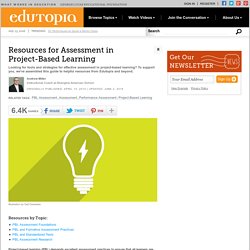
With good assessment practices, PBL can create a culture of excellence for all students and ensure deeper learning for all. We’ve compiled some of the best resources from Edutopia and the web to support your use of assessment in PBL, including information about strategies, advice on how to address the demands of standardized tests, and summaries of the research. PBL Assessment Foundations. Know Students Better: 15 Tools for Formative Assessment. When teachers know their students well, they can build strong connections that lead to better learning.
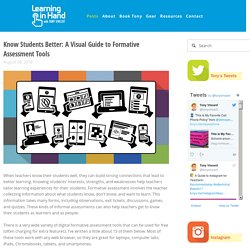
Knowing students’ interests, strengths, and weaknesses help teachers tailor learning experiences for their students. Formative assessment involves the teacher collecting information about what students know, don’t know, and want to learn. This information takes many forms, including observations, exit tickets, discussions, games, and quizzes. These kinds of informal assessments can also help teachers get to know their students as learners and as people. There is a very wide variety of digital formative assessment tools that can be used for free (often charging for extra features).
Webinar Developing entrepreneurial skills PBL course. Assessment and Rubrics. A collection of rubrics for assessing portfolios, group work/cooperative learning, concept map, research process/ report, PowerPoint, oral presentation, web page, blog, wiki, and other social media projects.
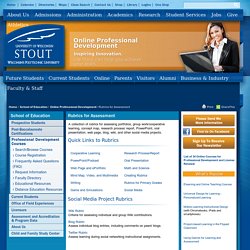
Quick Links to Rubrics Social Media Project Rubrics Wiki RubricCriteria for assessing individual and group Wiki contributions. Blog RubricAssess individual blog entries, including comments on peers' blogs. Twitter RubricAssess learning during social networking instructional assignments. Rubriche di valutazione per integrare le tecnologie nella didattica. Do No Harm: Flexible and Smart Grading Practices. My Edutopia post When Grading Harms Student Learning generated a lot of buzz.

Grading is an emotional subject, with strong-held opinions and ideas. I was really excited to see discussion on all sides of the issue. The best feedback for me was that, while many readers agreed with parts of the premise, I hadn't been specific on support strategies. Project Based Learning Checklists. Responster - Feedback made easy! Peer Assessment: Reflections from Students and Teachers. 9-12 Presentation Rubric (non-CCSS) Project Based Teaching Rubric. 6-12 Creativity & Innovation Rubric (non-CCSS) Take Three! 55 Digital Tools and Apps for Formative Assessment Success. There is no shortage of strategies, techniques, and tools available to teachers who use formative assessment in their classrooms.

It’s been over a year since we published our blog on digital tools and apps for formative assessment success and some of them we listed are no longer around. The good news is that there are new tools and apps that are available today that can help facilitate evidence of student learning. Here is an updated version of our list of digital tools and apps for formative assessment success. Share your tools, ideas, and thoughts with us so we can continue to keep this list growing and current. These 55 tools and apps for formative assessment success give teachers (and students) many options and opportunities for classroom success. 70+ Educational iPad Apps Curated by... - Educational Technology. Some Excellent Rubric Generators for Teachers. July 3, 2016 A few days ago we published here in EdTech and mLearning a collection of some interesting web tools teachers can use to create educational rubrics.
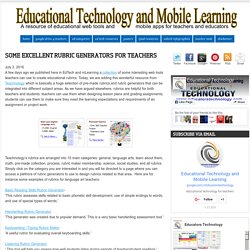
Today, we are adding this wonderful resource from Teachnology which is basically a huge selection of pre-made rubrics and rubric generators that can be integrated into different subject areas. As we have argued elsewhere, rubrics are helpful for both teachers and students: teachers can use them when designing lesson plans and grading assignments; students can use them to make sure they meet the learning expectations and requirements of an assignment or project work.
Teachnology’s rubrics are arranged into 10 main categories: general, language arts, learn about them, math, pre-made collection, process, rubric maker membership, science, social studies, and all rubrics. Basic Reading Skills Rubric Generator- Cooperative Learning: 7 Free PDF Assessment Instruments. Introduction Evaluating cooperative learning activities may seem like a Herculean task.
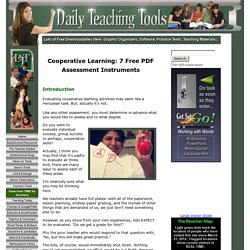
But, actually it's not. Like any other assessment, you must determine in advance what you would like to assess and to what degree. Do you want to evaluate individual success, group success or perhaps, cooperative skills? Actually, I think you may find that it's useful to evaluate all three. Creating a Rubric. Formative%20and summative assessment. Formative vs. Summative Assessment: What's the Difference? Formative and summative assessments are among the most common types of educational evaluations, each with its own distinct purpose.

Though the word "assessment" often conjures images of paper-and-pencil exams, our understanding of this topic has evolved greatly in recent years, along with our reasons for assessing and the types of assessments we give our students. Each type of evaluation has a specialized purpose. Examples of Formative Assessment. When incorporated into classroom practice, the formative assessment process provides information needed to adjust teaching and learning while they are still happening.

The process serves as practice for the student and a check for understanding during the learning process. The formative assessment process guides teachers in making decisions about future instruction. Here are a few examples that may be used in the classroom during the formative assessment process to collect evidence of student learning. MakingLearningVisibleResources - Ladder of Feedback. Creating a rubric that will be saved. Registering as a new user Before you begin creating a rubric you must register as a new user.

You'll only need to do this once, so if you are a returning user, please skip to the Returning user log in section. To register, scroll down on the homepage of RubiStar until you see the green arrow, like the one shown below, that says Register. RubiStar Home. 5 Excellent Rubric Making Tools for Teachers. June 18, 2016 Rubrics are scoring charts used to assess and evaluate a particular learning or teaching activity. As is explained in this guide, rubrics are helpful for both teachers and students: teachers can use them when designing lesson plans and grading assignments; students can use them to make sure they meet the learning expectations and requirements of an assignment or project work. Rubric making should not be a complicated task, it should only speak to the core requirements of a given task while channeling focus to the learning outcomes. There are a wide variety of web tools and mobile apps teachers can use to create rubrics.
Below is a collection of some of our favourite applications. 2 SATC AssessTools PeerAssessment 042913. 20 Simple Assessment Strategies You Can Use Every Day. 20 Simple Assessment Strategies You Can Use Every Day by Saga Briggs The ultimate goal of teaching is understanding. But sometimes it’s easier to talk than to teach, as we all know, especially when we need to cover a lot of material in a short amount of time. We hope students will understand, if not now then before test time, and we keep our fingers crossed that their results will indicate we’ve done our job. A guide to continuing professional development – Peer observation. Every Teacher’s Guide to Assessment. It’s not a stretch to say that assessment is a hot button issue in education; however, you’d be hard pressed to find an educator who doesn’t see the value in measuring student progress.
Assessments themselves have been vilified, when, in fact, it’s why assessments are given and how the data is used that is really the issue. The Glossary of Education Reform gives this great overview of what high-stakes testing is and how it impacts students, teachers, and schools.